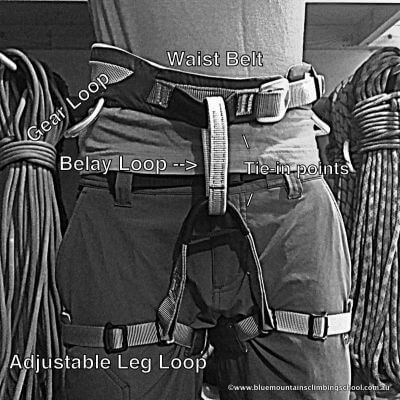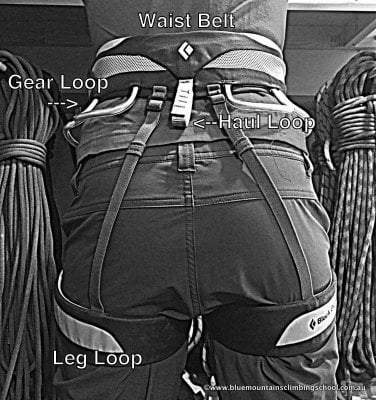
With so many climbing harnesses on the market and so many different features and styles to get your head around, it can be hard to know where to start. Tune in over the next few weeks as we take a look at climbing harnesses, their features, how to get the right fit and how to choose the best one for the kind of climbing you want to do.
For starters, here are the basic features of your harness and what they do:

Waist belt: The waist belt is a padded or webbing strap that goes around your waist. When you take a fall in a sit harness (the most common style used for rock climbing), the waist belt and the leg loops distribute the force of your fall so you land sitting upright (most of the time!).
Leg loops: These padded fabric or webbing loops go around your upper thighs. Depending on what the harness is designed for, leg loops can be adjustable with buckles, or fixed with elastic.
Belay loop: This thick webbing loop is one of the strongest parts of your harness, with a strength rating of around 15kN. This means it can handle forces roughly equivalent to 1,500kg – much more than you should be able to generate in a fall. The belay loop is where you attach your locking carabiner and device for belaying and abseiling.
Tie-in points: These stiff webbing loops (joining the waist belt and leg loops to the belay loop) are the attachment points for your lead climbing rope.

Gear loops: Gear loops are the small plastic or webbing loops attached to the waist belt. They may be rigid or flexible. This is where you hang your climbing gear, like carabiners and quick draws, when you’re not using it. Most harnesses have four or five gear loops, but some sport climbing harnesses have as few as two, and some big wall harnesses have more than 10. Gear loops are not strong enough to hold a fall.
Buckles: Climbing harnesses generally have one or two waist buckles. All buckles need to be doubled back or ‘locked’ so they can’t slip and undo. Most harnesses have either quick-adjust or standard buckles. Quick-adjust buckles are always doubled back (unless you undo them), making them convenient and quick – but make sure you always double check before tying in. If your harness has standard buckles you will need to ‘doubled back’ the webbing belt manually to prevent them from sliding open. More on this later.
Haul loop: You will find that some harnesses have this loop and some don’t. Sometimes they are rated to withstand a fall and can be used for hauling ropes on long aid or big wall climbs. Sometimes they are not strong enough to hold a fall, and are a good place to clip your chalk bag to your harness.
Now you can recognise the main features of your harness it’s time to look at how to get the right fit.


